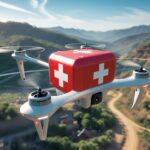In recent years, drones have emerged as a game-changing technology in various industries. One of the most promising applications is in healthcare, particularly in delivering medical supplies to remote and underserved areas. With the ability to bypass geographical barriers, drones are enhancing access to essential medicines, vaccines, and emergency aid where traditional transportation methods fail.
The Growing Need for Drone Medical Delivery
Many rural and remote communities struggle with limited access to healthcare due to poor infrastructure, long distances, and harsh terrain. Traditional delivery methods, such as trucks and helicopters, can be costly, slow, or even impossible in emergencies.
Drones offer a faster, more cost-effective, and efficient solution to these challenges. They can deliver lifesaving supplies within minutes, ensuring that patients receive timely medical attention. With recent advancements in drone technology, more healthcare organizations and governments are investing in drone delivery systems to bridge healthcare gaps.
How Drones Work in Medical Supply Delivery
1. Autonomous Flight Technology
Modern drones use AI-powered navigation systems to fly autonomously. They are equipped with GPS, obstacle detection, and weather monitoring features to ensure safe and accurate deliveries.
2. Medical Payload Capacity
Drones designed for medical use can carry a range of supplies, including:
- Vaccines and temperature-sensitive medications
- Blood and lab samples for testing
- Antivenoms for snake bites
- First aid kits and essential medicines
- Organ and tissue transplants (in some advanced models)
3. Speed and Efficiency
Drones significantly reduce delivery times. For instance, what takes an ambulance over an hour on rough terrain, a drone can accomplish in under 20 minutes. This speed can make the difference between life and death in emergency situations.
4. Remote Control and AI Integration
Most medical drones can be controlled remotely or operate on pre-programmed routes. AI-powered drones analyze real-time data, adjust flight paths, and optimize deliveries based on urgency and location.
Key Benefits of Drones in Healthcare
1. Faster Emergency Response
In critical conditions like heart attacks, strokes, or accidents, receiving medical supplies quickly is crucial. Drones can deliver Automated External Defibrillators (AEDs) or critical medicines within minutes, increasing survival rates.
2. Cost-Effective Solution
Compared to helicopters or ground transportation, drones are more affordable to operate. They require minimal human intervention, reducing labor and operational costs.
3. Overcoming Geographic Barriers
Drones can easily navigate through mountains, forests, and disaster-hit areas where traditional vehicles struggle. This makes them particularly valuable in natural disaster relief efforts.
4. Environmentally Friendly
Drones use electric power, reducing carbon emissions compared to fuel-powered delivery methods. This aligns with global sustainability goals in healthcare logistics.
Challenges Facing Drone Medical Deliveries
1. Regulatory Hurdles
Government regulations on drone usage vary across regions. Authorities must ensure that drones comply with safety, privacy, and air traffic regulations before widespread implementation.
2. Limited Payload Capacity
While drones are efficient for small medical packages, they currently lack the capacity to transport larger supplies or bulky medical equipment.
3. Weather and Environmental Constraints
Drones may face difficulties operating in extreme weather conditions, such as heavy rain, strong winds, or extreme temperatures, which can affect performance and reliability.
4. Security and Privacy Concerns
Cybersecurity threats, drone hacking, and potential misuse are concerns that need to be addressed to maintain secure and ethical operations.
Success Stories of Drone Medical Deliveries
1. Zipline’s Impact in Africa
Zipline, a U.S.-based drone delivery company, has successfully deployed medical drones in Rwanda and Ghana. Their drones deliver blood, vaccines, and medications to rural hospitals, drastically reducing delivery times from hours to minutes.
2. UPS Flight Forward in the U.S.
UPS, in collaboration with Matternet, launched the first FAA-approved drone delivery service in North Carolina. Their drones deliver lab samples between hospitals, streamlining the diagnostic process.
3. COVID-19 Vaccine Deliveries
During the pandemic, drones played a crucial role in delivering COVID-19 vaccines to remote regions worldwide, ensuring widespread immunization efforts without logistical barriers.
The Future of Drone Medical Deliveries
The future of drones in healthcare looks promising, with ongoing advancements in drone technology, AI, and logistics. Here’s what we can expect:
1. Increased Government and Private Sector Investments
With successful pilot programs, more governments and private organizations are funding drone healthcare initiatives, expanding their reach and capabilities.
2. Improved Battery Life and Payload Capacity
Next-generation drones will have enhanced battery life and the ability to carry larger medical payloads, allowing them to serve broader healthcare needs.
3. Integration with AI and Machine Learning
AI-driven drones will predict demand, optimize delivery routes, and provide real-time analytics to improve efficiency and responsiveness.
4. Expansion to Urban Healthcare Services
While drones currently focus on rural areas, future developments will integrate drones into urban hospital supply chains, reducing congestion and delivery delays.
Conclusion
Drones are revolutionizing medical supply delivery, offering life-saving solutions to remote and underserved areas. Their ability to overcome geographical barriers, reduce costs, and improve emergency response times makes them a critical asset in modern healthcare.
As technology advances and regulations evolve, we can expect drones to become an integral part of global medical logistics, ensuring healthcare reaches those who need it most.



